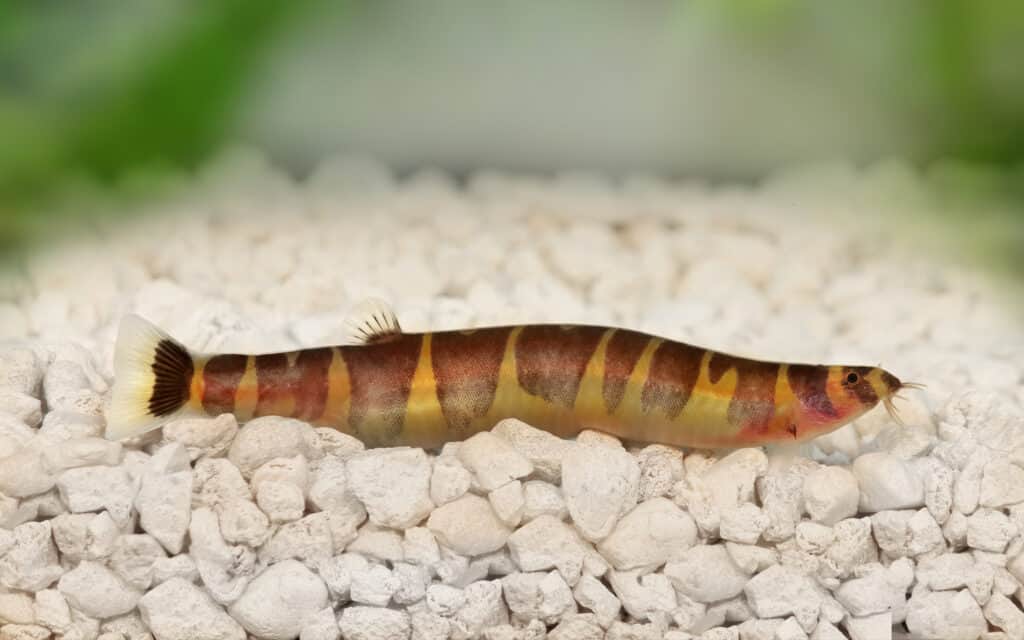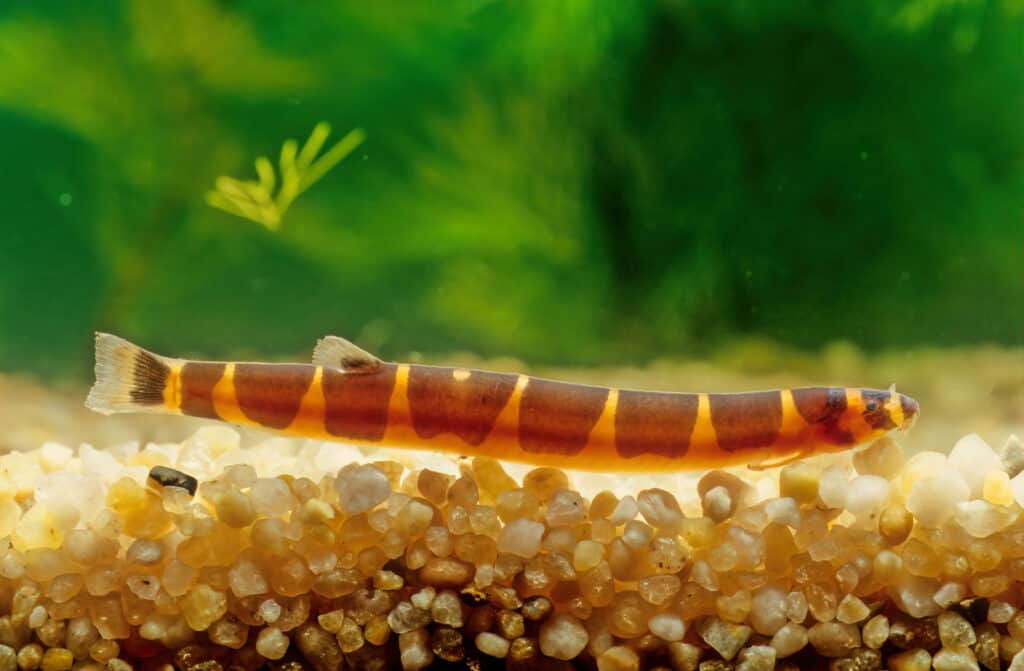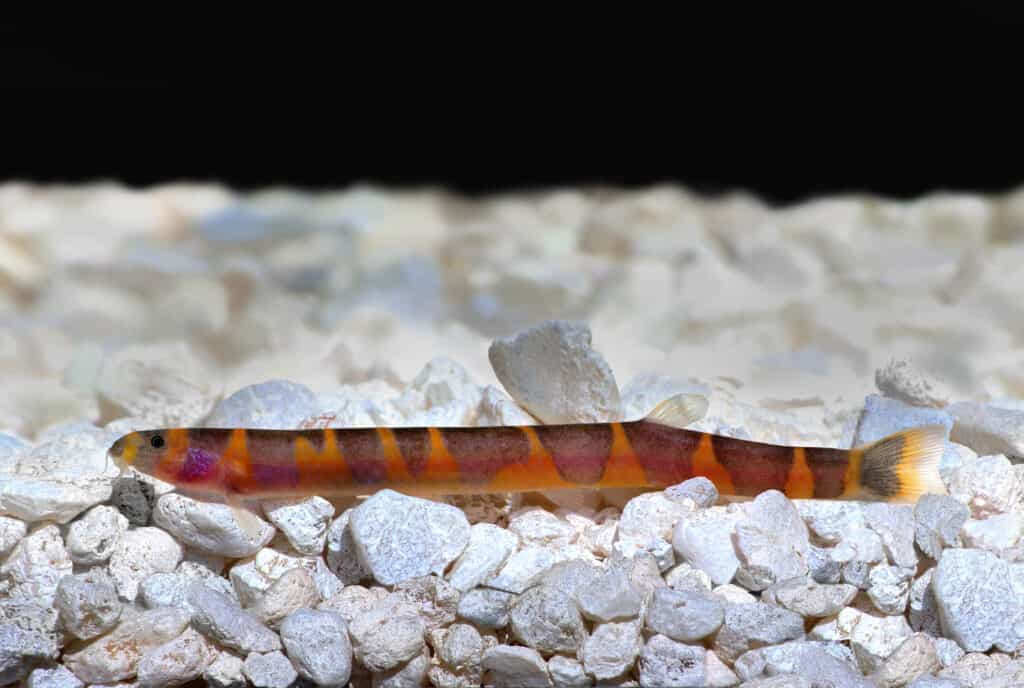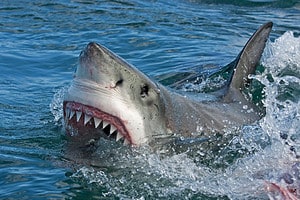The kuhli loach is an interesting addition to any aquarium. Its eel-like form and tiger print will certainly draw your guests’ attention. On the other hand, this fish gets startled quite easily, so you might not be able to see it most of the time.
Nevertheless, if you plan to get one for your aquarium, knowing what kuhli loaches eat is essential. That’s why we’re here – to help you further understand what fish type you’ll bring home and what it needs to grow and develop properly!
What Are Kuhli Loaches?

Kuhli loaches are part of the
Cobitidae(loach) family.
©iStock.com/Mirko_Rosenau
Kuhli loaches, going by the scientific name of Pangio kuhlii, are freshwater fish and part of the Cobitidae (loach) family. They originate from the Malay Peninsula and Indonesia. Kuhli loaches resemble eels. These fish are nocturnal in the wild but reclusive and easily startled in an aquarium.
The body of a kuhli loach is adorned by up to 15 black or dark brown vertical lines, resembling a tiger print. The rest of the body is salmon pink or yellow, while the fish’s underside is of a lighter shade. A mature kuhli loach is about 2.75 inches long. Some specimens can grow to be about 4 inches.
The species makes for a perfect aquarium pet, as it can live for roughly 14 years.
What Do Kuhli Loaches Eat?

Kuhli loaches eat larvae, plants, and smaller crustaceans.
©iStock.com/Miropa
Kuhli loaches are classified as a scavenger fish species. As a result, they eat anything that ends up on the bottom of the river or aquarium. An omnivorous species, kuhli loaches eat larvae, plants, and smaller crustaceans. In the wild, the species usually feeds during the night. In an aquarium, however, it can get used to day feeding. It’s recommended to feed them when you feed the other fish in the tank. Although they won’t often look for food during the day, kuhli loaches will appreciate the leftovers during the night.
When it comes to feeding them in an aquarium, kuhli loaches eat frozen bloodworms, pellets, live blackworms, and brine shrimp. Generally, their diet consists mainly of meat. Kuhli loaches won’t eat aquarium-specific plants and will rarely feed on snails. They might also steer clear of certain shrimp species.
A List of Foods Kuhli Loaches Eat
These are the majority of the foods a kuhli loach eats, both in the wild and in an aquarium.
- Larvae
- Plants
- Crustaceans
- Bloodworms
- Blackworms
- Brine shrimp
- Flake food
- Algae tablets
- Mysis shrimp
- Live Daphnia
How to Properly Feed Kuhli Loaches

It is recommended to feed kuhli loaches with the lights out during the night.
©iStock.com/Mirko_Rosenau
While in aquariums, kuhli loaches are known to be easily startled and rather reclusive. As a result, other fish might end up eating their food. If this happens, it is recommended to feed kuhli loaches with the lights out during the night. Then, the other fish in your aquarium will be sleeping, and your kuhli loaches will be able to scavenge food in their rhythm.
If you plan to grow some kuhli loaches in your aquarium, below, you’ll find a detailed feeding guide that will greatly help you. Please note that portions are per fish.
| Type of Food | Frequency | Quantity |
|---|---|---|
| Bloodworms (frozen) | Up to 2 times a week | a pinch |
| Bloodworms (live) | Up to 2 times a week | ¼ teaspoon |
| Brine shrimp (live) | Only once a week | 1 to 2 specimens |
| Flake food | Up to 3 times a day | 90 seconds worth of eating |
| Algae tablets | Up to 2 times a week | 1 tablet per 10 fish |
Generally, kuhli loaches should eat in moderation, especially when it comes to meaty foods, because they can easily get overfed. Two balanced meals a day should be enough. The same applies to vegetables and other supplementary foods. They should eat those up to two times a week – and be fed as much as they can ingest in 90 seconds.
What Should You Know Before Getting a Kuhli Loach?
Growing fish can be quite interesting and is often regarded as a long-term hobby. For example, kuhli loaches can live up to 14 years in optimal conditions. You’ll have a buddy for a long time if you decide to grow a specimen of this species.
Here are a couple of other things you should know before getting a kuhli loach:
- Kuhli loaches can grow up to 4 inches in aquariums;
- The ideal tank temperature for kuhli loaches is 73-86 °F; this means that the species is quite adaptable and will survive in many types of environments;
- The ideal water pH level for kuhli loaches is 5.5 to 6.5. At the same time, aquarium water shouldn’t have a hardness of over 5.0 dGH;
- Despite being pretty social, kuhli loaches are considered neither shoaling nor schooling fish. It is best to pair them with medium-sized groups of fish in your aquarium or with others of their own species;
- The species is bottom-dwelling. This means that your aquarium must be equipped with a gravel substrate, preferably smooth and fine, as well as other hiding spots.
Up Next:
- Types of Pet Fish That Live Long
- The Best Aquarium Cabinets for 2022
- The Best Fish Background for Your Aquarium
The photo featured at the top of this post is © iStock.com/Miropa
Sources
- Kidadl, Available here: https://kidadl.com/facts/animals/kuhli-loach-facts
- Smart Aquarium Guide, Available here: https://smartaquariumguide.com/kuhli-loach-feeding-guide/
- Fishkeeping Forever, Available here: https://fishkeepingforever.com/kuhli-loach-feeding-guide/
- Aquarium Coop, Available here: https://www.aquariumcoop.com/blogs/aquarium/care-guide-for-kuhli-loaches
Thank you for reading! Have some feedback for us? Contact the AZ Animals editorial team.






